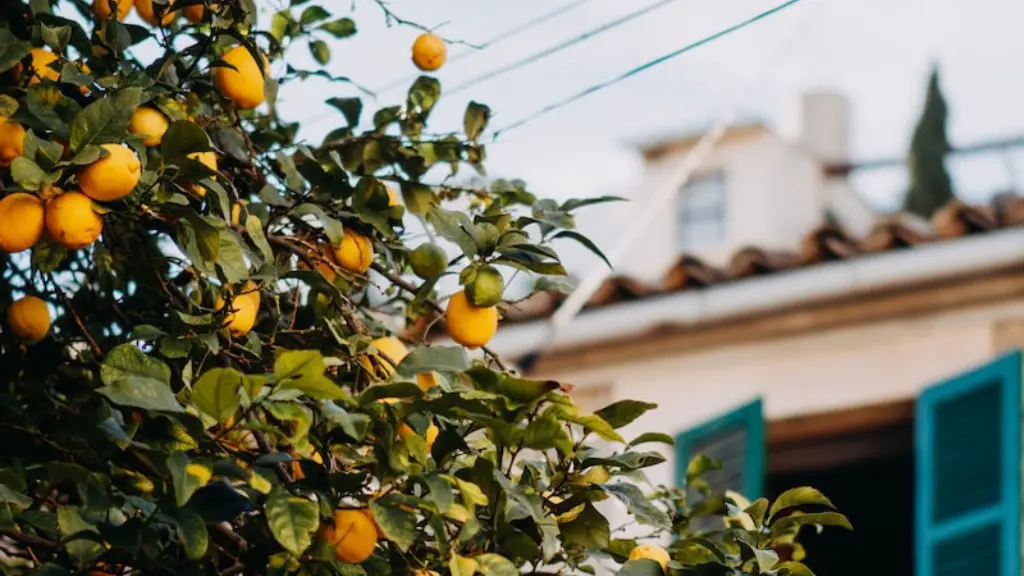The life cycle of a lemon tree begins with the germination of the lemon seed. Lemon seeds can be planted outdoors in warmer climates or in a container in colder climates. As soon as the lemon seed has been planted in the soil, it is exposed to water, oxygen and proper nutrients, which leads to its sprouting into a young seedling. As the seedling begins to grow, its roots will grow deeper into the soil and its branches will emerge and grow outwards. The seedling then develops into a lemon tree that produces four or five years of foliage before it is ready to bear fruit.
The lemon tree continues to grow, reaching up to 20 feet tall. Most lemon trees need full sun to perform best, but some varieties can tolerate some shade. In order to maintain plant health, lemon trees should be watered regularly and fertilized three times a year with a balanced fertilizer. It is important to prune lemon trees regularly to promote strong growth and encourage fruit production.
When the lemon tree is mature enough and has consistent conditions, it will start to produce fruits. The ripening period for a lemon can take up to two months. During this time, the fruit should be protected from harsh weather and regular pest control should be done. As the lemon fruits mature, they should be harvested regularly to ensure optimal yield and quality.
After the last lemon fruits are harvested, the lemon tree begins to go dormant until the following spring. During this time, it is important to keep the tree healthy by providing adequate nutrients and water. As the dormant period comes to an end, the lemon tree will start to break dormancy and will be ready to flower and start producing fruits again.
The life cycle of a lemon tree will then repeat itself, each year resulting in increased fruit production. Lemon trees can live up to 80 years and produce fruits for many decades.
Harvesting
Harvesting is an important part of the lemon tree’s life cycle. It is important to harvest lemons when they are fully mature and ripe, as this will ensure optimal flavor, texture and yield. Most lemons should be picked when the flesh is lightly yellow and the flavor is at its peak. Citrus fruits should not be left on the tree for too long to avoid over-ripening, which can cause the quality of the fruit to deteriorate.
In order to maximize the fruit yields of the lemon tree, it is important to ensure regular and efficient harvesting practices, such as selective thinning, proper pruning and adequate irrigation. Harvesting lemons should be done carefully and gently in order to avoid any damage to the fruit.
Preservation
Preserving lemons is essential in order to maximize their shelf-life and maintain their quality. Before lemons are preserved, they should be washed thoroughly with cool water to remove any dirt or pesticides. Then, the lemons should be cut into slices and the seeds should be removed. They can then be preserved by a variety of methods, such as drying, freezing, canning or pickling.
When lemons are dried, they should be dried slowly in a dark area at a temperature of 120°F. Lemons can also be frozen using a vacuum sealer, which will help to maintain the quality of the lemon for up to a year. If preserving lemons by canning or pickling, they should be placed in sterilized jars and submerged in a mixture of water and vinegar.
Disease
Citrus trees are susceptible to a number of different diseases, which can significantly reduce the yield and quality of the lemon fruit. Therefore, it is essential to regularly inspect the tree for signs of disease, such as wilting leaves, yellowing foliage and stunted growth. Common diseases of lemon trees include citrus canker, citrus greening, citrus mold and citrustrunk rot, and can be treated with fungicides or other treatments.
Pests and Predators
In order to maintain the health of a lemon tree, it is important to be aware of and guard against potential pests and predators. Common pests of lemon trees include aphids, thrips, mites, mealybugs and scale. Predators can also cause damage to a lemon tree, such as birds, deer, rabbits and even wild boars. To prevent damage from pests and predators, homeowners can use a combination of insecticides, deterrents and physical barriers to protect their tree.
Nutrition
In order for new lemon trees to thrive, it is essential to give them proper nutrition from the beginning. The soil around a lemon tree should be amended with organic matter and fertilized with a balanced fertilizer to ensure optimal growth. Lemon trees should also be watered regularly and mulched to ensure adequate moisture in the soil. In addition, it is important to check the pH levels of the soil to make sure it is not too acidic or alkaline.
Environmental Factors
Geographical location and climatic conditions also have a significant effect on the growth and fruiting of a lemon tree. Lemon trees typically require warm climates with lots of sunshine. In colder climates, lemon trees should be planted in pots and brought indoors during winter to prevent frost damage. In addition, the soil should be well-draining and free of standing water to avoid root rot, and the tree should be planted away from areas of high winds.



